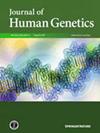A novel missense pathogenic variants of TMEM53 in an Iranian family with craniotubular dysplasia, Ikegawa type
IF 2.5
3区 生物学
Q2 GENETICS & HEREDITY
引用次数: 0
Abstract
Craniotubular dysplasia, Ikegawa type (CTDI) is a rare autosomal recessive skeletal dysplasia characterized by hyperostosis of the calvaria and skull base, metadiaphyseal undermodeling of the long tubular bones, and mild shortening and diaphyseal broadening of the short tubular bones. Its causal gene is TMEM53. Six CTDI families have been reported; however, its clinical course and prognosis still remain to be determined. Here, we report two Iranian siblings carrying a novel homozygous missense variant of TMEM53. The affected individuals were referred for progressive severe visual loss of unknown cause. The patient had severe optic atrophy and optic canal narrowing. Radiographic evaluation suggested the diagnosis of CTDI, which was confirmed by the identification of TMEM53 variant (c.704G > T, p.R235L) co-segregating in the consanguineous family. The proband underwent trans-nasal endoscopic optic canal decompression and showed remarkable improvement in visual acuity and daily visual tasks. We recommend early comprehensive clinical and genetic evaluation followed by proper treatment to improve the prognosis of CTDI.

一种新的错义致病变异TMEM53在伊朗家庭与颅管发育不良,Ikegawa型。
颅管发育不良,Ikegawa型(CTDI)是一种罕见的常染色体隐性骨骼发育不良,其特征是颅骨和颅底肥大,长管状骨干骺端发育不全,短管状骨轻度变短和干骺端变宽。其致病基因是TMEM53。据报道有6个CTDI家族;但其临床病程及预后尚不明确。在这里,我们报告了两个携带TMEM53的新型纯合错义变体的伊朗兄弟姐妹。受影响的个体被转诊为原因不明的进行性严重视力丧失。患者有严重的视神经萎缩和视神经管狭窄。影像学检查提示CTDI的诊断,通过鉴定TMEM53变异(c.704G > T, p.R235L)在近亲家族中共分离,证实了CTDI的诊断。先证者接受经鼻内窥镜视神经管减压术,视力及日常视觉活动均有显著改善。我们建议早期进行全面的临床和遗传学评估,然后进行适当的治疗,以改善CTDI的预后。
本文章由计算机程序翻译,如有差异,请以英文原文为准。
求助全文
约1分钟内获得全文
求助全文
来源期刊

Journal of Human Genetics
生物-遗传学
CiteScore
7.20
自引率
0.00%
发文量
101
审稿时长
4-8 weeks
期刊介绍:
The Journal of Human Genetics is an international journal publishing articles on human genetics, including medical genetics and human genome analysis. It covers all aspects of human genetics, including molecular genetics, clinical genetics, behavioral genetics, immunogenetics, pharmacogenomics, population genetics, functional genomics, epigenetics, genetic counseling and gene therapy.
Articles on the following areas are especially welcome: genetic factors of monogenic and complex disorders, genome-wide association studies, genetic epidemiology, cancer genetics, personal genomics, genotype-phenotype relationships and genome diversity.
 求助内容:
求助内容: 应助结果提醒方式:
应助结果提醒方式:


